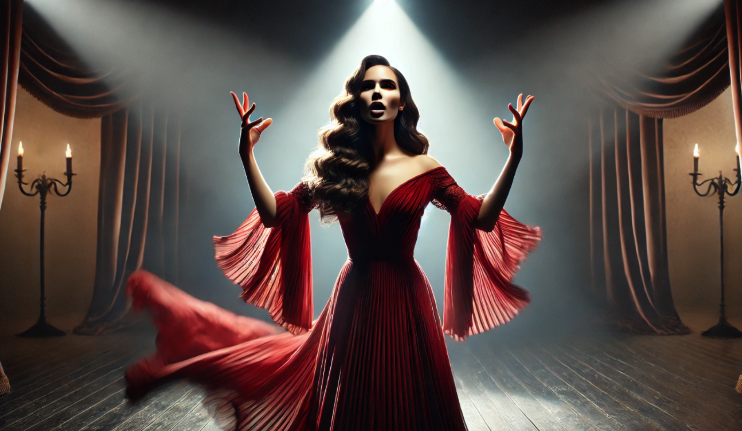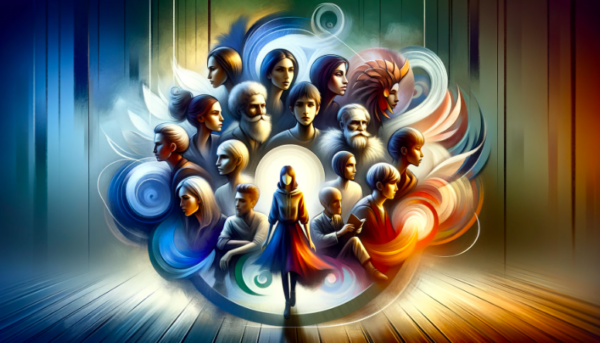Life has a funny way of keeping us on our toes. Just when you finally bring an umbrella to work, the sun blazes all day. Or maybe the fire station burns down. Ironic, isn’t it? Life’s twists and turns are often more unpredictable than fiction, which is exactly why different types of irony are some of the most powerful storytelling tools in a writer’s arsenal.
At its core, the irony definition is deceptively simple: it’s when there’s a contrast between expectations and reality. This literary device creates an unexpected outcome that can make readers laugh, gasp, or even cry. Whether it’s dramatic irony that builds suspense, situational irony that delivers shocking plot twists, or verbal irony that adds wit and humor, irony is what often turns ordinary stories into unforgettable ones.
In fact, studies suggest that irony enhances cognitive engagement by prompting readers to process meaning more deeply. A 2019 study published in Psychonomic Bulletin & Review found that ironic statements require more cognitive effort to interpret, making them more memorable and emotionally impactful than literal statements.
This article will explore the 3 types of irony, offering famous examples of irony in literature and practical tips for writers who want to craft their own ironic situations.
Mastering irony isn’t just about surprising your audience; it’s about deepening your story and making every twist feel both clever and inevitable. So, what are the types of irony that make stories unforgettable? Let’s find out!
Dramatic Irony: The Art of Letting Your Characters Walk into Traps
Few things are more deliciously painful than watching a character whose own life unknowingly marches toward disaster while the audience can do nothing but watch. This is the essence of dramatic irony—a powerful literary device where the audience knows crucial information that the characters do not. This gap in knowledge creates tension, suspense, and sometimes even humor, as readers or viewers anticipate the inevitable moment when the truth is revealed.
How Dramatic Irony Works
Dramatic irony occurs when the audience is a step (or ten) ahead of the characters. This awareness can make the audience feel like silent participants in the story, watching the characters make decisions based on incomplete or false information. The result? Heightened suspense, emotional impact, and deep engagement.
This device can evoke a range of emotions. It can be tragic, as in stories where characters’ ignorance leads to heartbreaking consequences. It can be terrifying in horror films when the audience waits for a character to discover the killer lurking in the shadows. Or, it can be darkly humorous when a character confidently acts on false assumptions, much to the audience’s amusement.
Famous Examples of Dramatic Irony
One of the most iconic dramatic irony examples comes from William Shakespeare’s Romeo and Juliet. Juliet takes a potion to appear dead, but Romeo, unaware of this plan, believes she has truly died. His reaction leads to a tragic chain of events that the audience sees unfolding long before the characters do.
In horror films, this technique is a staple. Imagine a character creeping into a dark basement while the audience knows the killer is hiding there. The character’s blissful ignorance makes the audience squirm, holding their breath until the inevitable strike.
How Writers Can Use Dramatic Irony
To use dramatic irony effectively, writers should carefully decide what secrets to share with the audience and what to keep from the characters. This balance builds tension as readers anticipate when and how the truth will come out to other characters.
- Create Suspense: Let the audience know something dangerous is about to happen while the character remains clueless.
- Heighten Tragedy: Reveal a character’s fatal flaw or mistake that will lead to their downfall.
- Add Humor: Use misunderstandings between characters to create amusing situations the audience can see coming.
When used skillfully, dramatic irony draws readers deeper into the story, making them feel involved in every twist and turn. It’s a timeless tool that writers can wield to build suspense, stir emotions, and leave audiences hanging on every word.
Verbal Irony: Sarcasm’s Smarter Cousin
Words can be tricky little things. Sometimes, what a character says isn’t exactly what they mean—and that’s where verbal irony steps in. By definition, verbal irony occurs when someone says something but means the opposite, often to emphasize a point, add humor, or highlight absurdity. It’s a clever rhetorical device that allows writers to layer dialogue with wit, sarcasm, and sometimes even subtle critique.
Verbal Irony vs. Sarcasm: Know the Difference
It’s easy to confuse verbal irony with sarcasm, but they aren’t identical twins—more like witty cousins. Verbal irony isn’t always designed to sting; it can be lighthearted, insightful, or even tragic. Sarcasm, on the other hand, typically carries a sharper edge, often meant to mock or belittle.
For example, if a student walks into class late during a storm and the teacher says, “Nice weather we’re having!”—that’s verbal irony. There’s no intent to insult, just a playful acknowledgment of the obvious. Now, if the teacher says, “Oh, brilliant, you’re late again. What a surprise,” that’s leaning into sarcasm.
Famous Examples of Verbal Irony
One of the best examples of verbal irony comes from Jane Austen’s Pride and Prejudice. Mr. Bennet, famous for his dry wit, often uses verbal irony to poke fun at others. When he says, “You must be two of the silliest girls in the country,” to his daughters, he’s not literally calling them the silliest—his intended meaning is more affectionate teasing than outright insult.
In everyday life, verbal irony pops up all the time. Imagine someone staring at a mountain of paperwork and muttering, “Oh, great, another meeting. Just what I needed.” The literal meaning clashes with what they actually feel, making the statement ironically effective.
How Writers Can Use Verbal Irony
Writers can use verbal irony to add depth, humor, and subtle commentary to their stories. Here’s how:
- Add Humor and Wit: A well-placed ironic remark can make dialogue sparkle and characters more relatable.
- Highlight Absurdity: Use ironic understatement or overstatement to reveal how ridiculous a situation is.
- Develop Character Voice: A character who frequently uses verbal irony might come across as clever, cynical, or even vulnerable.
- Create Tension: When a character’s words hide their true feelings, it can build emotional complexity.
For example, using an ironic understatement like, “Well, that went well,” after a total disaster adds a layer of dry humor. On the flip side, a great example is an ironic overstatement like, “This is the best day ever,” after spilling coffee on a report can convey frustration without being heavy-handed.
Mastering verbal irony is about striking a balance between the intended meaning and the literal meaning, giving writers a versatile tool to entertain, provoke thought, and subtly critique. Whether playful or biting, verbal irony adds personality and punch to every story.
Situational Irony: Plot Twists That Punch You in the Face
Few things are more satisfying in a story than a jaw-dropping twist—especially when it feels like the universe itself is in on the joke. This is the heart of situational irony, a literary device where the actual outcome is the complete opposite of what was expected. Unlike other forms of irony, situational irony occurs when both the audience and the characters are equally blindsided by the expected outcome of an event that defies logic or expectation.
Understanding Situational Irony
At its core, situational irony flips the script. It plays with the gap between what characters (and readers) anticipate and what actually happens. This reversal creates surprise, humor, or even a harsh dose of reality. The power of one situational irony example lies in its ability to make readers rethink the rules of the world they’re immersed in.
An unexpected twist or outcome is key. If the audience can predict the twist, it loses its punch. But when a turn of events feels both shocking and believable, it delivers a gut punch that stays with readers long after the story ends.
Famous Examples of Situational Irony
One classic example of situational irony is O. Henry’s The Gift of the Magi. A young couple, deeply in love but financially struggling, secretly sacrifice their most prized possessions to buy gifts for each other. The wife sells her hair to buy a chain for her husband’s watch, while the husband sells his watch to buy combs for his wife’s hair. Their selfless acts of love end up making their gifts useless—an ending that’s equal parts sweet and heartbreaking.
How Writers Can Use Situational Irony
Crafting impactful ironic situations requires careful setup and timing. Here are a few ways to wield situational irony effectively:
- Subvert Expectations: Lead readers to believe one thing, then deliver the opposite—but make sure it still makes sense in the story’s world.
- Balance Surprise with Logic: A great plot twist is surprising but not random. The ending should feel unexpected yet inevitable.
- Play with Themes: Use irony to highlight the story’s deeper messages. In The Gift of the Magi, the irony underscores the theme of selfless love.
- Foreshadow Without Revealing: Drop subtle hints that make the twist satisfying when it lands, not predictable.
Situational irony is most powerful when it feels like fate is playing tricks on both the characters and the audience. It delivers the kind of shock that leaves readers reeling, making your story unforgettable. So go ahead—set up those expectations and then knock them down.
Tragic Irony: Destiny’s Cruel Joke
Sometimes, the most devastating moments in literature come not from surprise but from inevitability. Tragic irony is a powerful form of dramatic irony often found in tragedies, where the audience knows a character’s fate long before the character does. This gap in knowledge turns every hopeful decision and bold action into a step closer to disaster, making the downfall even more heartbreaking.
In tragic irony, the audience is painfully aware of how events will unfold, while the character, blinded by ambition, pride, or ignorance, marches toward doom. This literary device intensifies emotional impact because readers are powerless to intervene, forced to watch as characters unknowingly seal their own fate. It’s a cruel but effective tool that heightens tension and deepens the tragedy.
Famous Examples of Tragic Irony
One of the most iconic examples of tragic irony comes from the Greek tragedy of Oedipus Rex by Sophocles. In his desperate attempt to escape a prophecy that he will kill his father and marry his mother, Oedipus takes actions that unknowingly lead him to fulfill it. The audience knows the truth from the beginning, making his journey from ignorance to horrific realization all the more tragic.
Similarly, in William Shakespeare’s Macbeth, the title character misinterprets a prophecy that he cannot be harmed by anyone “born of a woman.” Believing himself invincible, Macbeth’s unchecked ambition spirals out of control. Ironically, he is ultimately killed by Macduff, who was born via cesarean section—technically not “born of a woman.” Macbeth’s ignorance of this loophole drives him to his inevitable downfall.
How Writers Can Use Tragic Irony
To effectively use tragic irony, writers must skillfully reveal just enough to the audience while keeping the characters in the dark. Here’s how:
- Foreshadow the Inevitable: Drop subtle hints that allow the audience to piece together the tragic outcome before the character does.
- Highlight Character Flaws: Let the character’s pride, ambition, or stubbornness lead them toward their fate.
- Build Tension: Make every decision feel like it’s leading to salvation, even though the audience knows it’s leading to ruin.
Tragic irony is one of the major types of irony that leaves readers emotionally wrecked—in the best way. By letting the audience in on the cruel joke of fate, writers can craft stories that are as haunting as they are unforgettable.
Other Types of Irony: The Lesser-Known But No Less Savage Forms of Irony
While dramatic, verbal, and situational irony steal most of the spotlight, several lesser-known forms of irony quietly deliver some of the most cutting twists in literature. These subtle but powerful tools can deepen themes, expose flaws, and challenge readers’ expectations in unexpected ways. Let’s meet these underrated players.
Cosmic Irony: When the Universe Mocks You
- Also known as “irony of fate,” cosmic irony occurs when a higher power—whether fate, the gods, or the universe itself—seems to toy with human hopes and efforts. It highlights how powerless people can be against forces beyond their control. A pop culture nod to this is Alanis Morissette’s song “Ironic”, packed with unlucky twists like rain on your wedding day. In literature, this often appears when a character works hard to avoid a bad outcome, only to trigger it instead.
Historical Irony: The Past’s Painful Punchlines
- Historical irony happens when actions meant to prevent a situation end up causing it—or when events take a turn that directly contradicts intentions. A chilling example is the Treaty of Versailles, designed to secure lasting peace after World War I but ultimately fueling the conditions that led to World War II. It’s a brutal reminder that good intentions don’t always lead to good outcomes.
Socratic Irony: The Art of Playing Dumb
- In Socratic irony, a character feigns ignorance to draw out another person’s flaws or contradictions. Named after the philosopher Socrates, who pretended not to know answers to provoke deeper thinking, this literary technique is often used to expose hypocrisy or ignorance. Think of detectives who act clueless to get suspects to slip up.
Structural Irony: The Story Lies to You
- Structural irony occurs when a story is built around a naive or unreliable narrator whose perspective contradicts the reality of the narrative. A perfect example is Voltaire’s Candide, where the overly optimistic protagonist views the world through rose-colored glasses despite constant disasters. Here, the structural irony lies in the gap between the character’s perception and the reader’s understanding.
These forms of irony may not always scream for attention, but when used well, they sharpen a story’s edge and give readers something to think about long after the final page.
How to Master Irony in Your Writing: Wielding Irony Like a Literary Sword
Irony isn’t just a clever twist—it’s a powerful storytelling tool that can sharpen your writing, deepen your themes, and keep readers hooked. Like any good weapon, it must be used skillfully. When writers wield irony with precision, it can deliver suspense, humor, or heartbreak in ways that leave a lasting impact.
Practical Tips for Mastering Irony
- Choose the Right Type of Irony: Not all irony fits every story. Use dramatic irony to create suspense, verbal irony for wit and sarcasm, and situational irony for shocking plot twists. Match the irony to your narrative’s tone and purpose.
- Balance Subtlety and Clarity: Irony should make readers think, not confuse them. Make sure your literary device is clear enough to be understood but subtle enough to feel natural.
- Add Humor or Emotional Depth: A well-placed ironic moment can add humor to lighten tension or add emotional weight to a tragic scene. Let irony amplify your story’s tone.
- Avoid Clichés: Readers can spot tired twists a mile away. Keep your ironic moments fresh and original by flipping common expectations in new and creative ways.
Experiment and Take Risks
The best writers aren’t afraid to play with irony. It’s a versatile literary technique that can turn an ordinary story into something unforgettable. Whether you want to make readers laugh, gasp, or reflect, irony can be the secret weapon that makes your storytelling truly shine.
Your Publishing Journey Awaits – Start NowIrony – Because Life (and Literature) Loves a Good Twist
From the tension of dramatic irony to the wit of verbal irony and the shock of situational irony, each form of irony brings a unique edge to storytelling. These different types of irony allow writers to craft stories that surprise, entertain, and resonate. Whether it’s fate playing tricks or characters blinded by their own flaws, irony adds depth, humor, and emotional weight to any narrative.
Great stories are built on unexpected turns, and irony is the ultimate powerful storytelling tool to deliver those unforgettable moments. So why not embrace the unexpected and let your stories take a twist your readers won’t see coming?Ready to sharpen your storytelling skills? Start weaving irony into your writing and publish them with Spines, the ultimate tool for crafting stories that captivate. Try it today and turn your ideas into page-turning narratives!
FAQ – The Different Types of Irony
Q: What are the 3 types of irony and their meanings?
The three main types of irony are verbal irony, situational irony, and dramatic irony.
- Verbal irony occurs when someone says the opposite of what they mean, often in a sarcastic or humorous way.
- Situational irony happens when there is a contrast between what is expected to happen and what actually occurs.
- Dramatic irony is when the audience knows something that the characters do not, creating suspense or humor.
Q: What are 3 dramatic irony examples?
Dramatic irony is frequently used in literature and film. Some classic examples include:
- Romeo and Juliet – The audience knows Juliet is alive, but Romeo believes she is dead.
- Oedipus Rex – Oedipus unknowingly fulfills the prophecy he tried to avoid.
- Titanic (the movie) – Viewers know the ship will sink, while the characters believe it is unsinkable.
Q: What is an example of situational irony?
A famous example of situational irony is in The Gift of the Magi, where a wife sells her hair to buy a watch chain for her husband, only to find out he sold his watch to buy hair accessories for her. The outcome is unexpected and contrasts sharply with the characters’ intentions.
Q: Is verbal irony the same as sarcasm?
While verbal irony and sarcasm are related, they are not always the same. Sarcasm is a form of verbal irony that is often used to mock or ridicule, while verbal irony in general can be humorous or even tragic without being mean-spirited.
Q: What is an example of cosmic irony?
Cosmic irony, also called “fate irony,” occurs when destiny or a higher power seems to manipulate events in an ironic way. A classic example is fate in Greek tragedies, where characters try to escape their destiny but unintentionally fulfill it, as seen in Oedipus Rex.
Q: What is an example of structural irony?
Structural irony occurs when a work is written with a framework that contradicts reality. One example is Jonathan Swift’s A Modest Proposal, where the narrator seriously suggests an outrageous idea (eating babies) to criticize societal issues. The entire structure of the essay is ironic.
Q: What are some famous irony examples in literature?
Some of the most famous examples of irony in literature include:
- Dramatic irony – The audience knows Hamlet’s plan, but the other characters do not (Hamlet).
- Situational irony – The fire station burns down.
- Verbal irony – In Julius Caesar, Mark Antony repeatedly calls Brutus “an honorable man” while implying the opposite.








